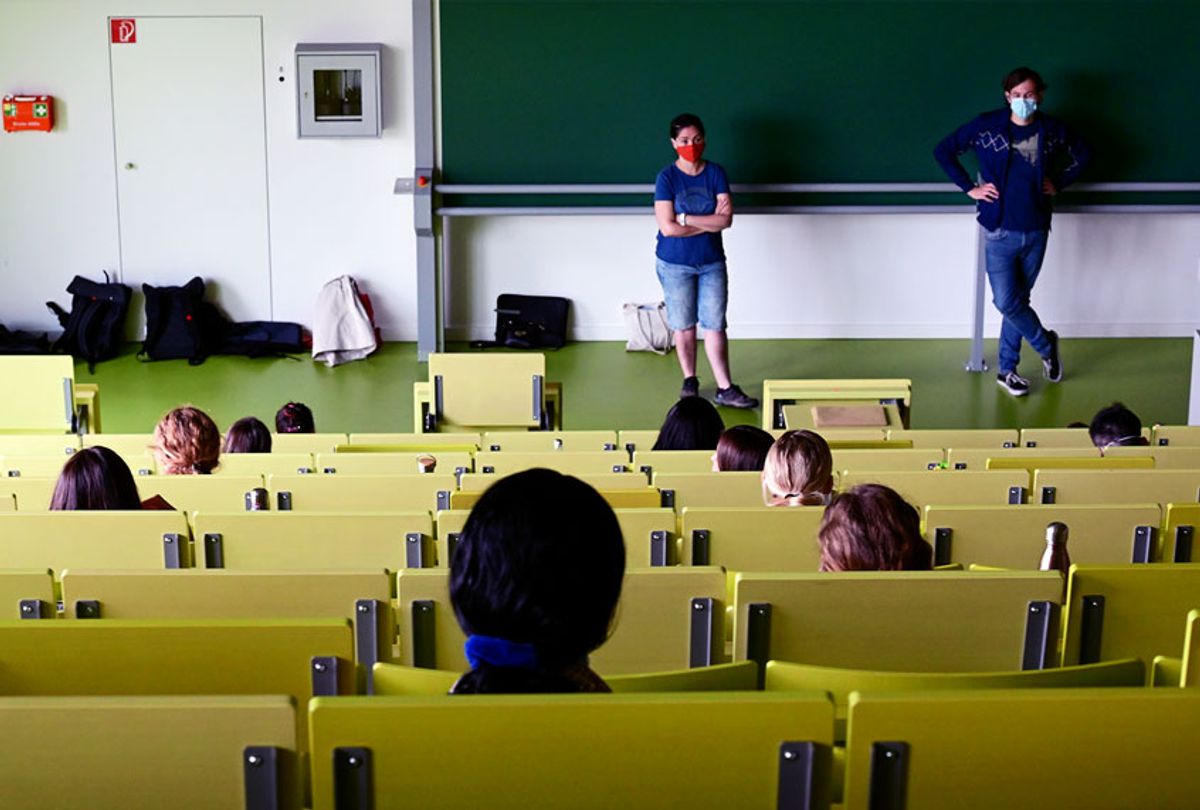The coronavirus pandemic has presented American colleges with a seemingly no-win dilemma: Do they resume in-person learning — which, if done wrong, could put thousands of students at risk — or only conduct classes remotely, exacting a financial toll on said colleges and diluting the on-campus college experience many students desire?
A pair of news stories, from opposite sides of the Mississippi River, reveals just how high the stakes are.
The University of Alabama–Tuscaloosa is reported to have 566 confirmed positive cases of COVID-19 among faculty, students and staff on their Tuscaloosa campus. In a statement made on Monday morning, President Stuart Bell characterized the challenge facing the school as one of needing to "identify where does the virus thrive and where does the virus spread, and how can we work together with our students, with our faculty and with our staff to make sure that we minimize" incidents and spread.
Perhaps in response to news reports about students socializing in seemingly unsafe environments, Bell added that "it's not student behavior, OK. It's how do we have protocols so that we make it to where our students can be successful, and we can minimize the impact of the virus."
On the west coast, there is the case of the University of Southern California (USC). According to a memorandum published on Monday by Dr. Sarah Van Orman, chief health officer for USC Student Health, more than 100 students at the college are in two-week quarantines after being exposed to infected individuals. Orman clarified that all of the infected students resided in off-campus living environments.
These two colleges are hardly alone. The University of North Carolina–Chapel Hill announced last week that it was transitioning to remote classes after dorms, a fraternity and other student housing saw outbreaks of COVID-19. Syracuse University suspended 23 students for having a large gathering that, they argued, could have required the whole campus to shut down. Notre Dame University has stopped in-person instruction for two weeks after 147 students tested positive on their campus.
USC, incidentally, is providing instruction almost entirely online, while University of Alabama–Tuscaloosa is primarily giving classes in-person. Other colleges are planning variations on these two policy approaches, which are not a strict binary. According to the Chronicle of Higher Education, 27 percent of American colleges are teaching primarily online, 20 percent are teaching classes primarily in-person, 15 percent are using a hybrid approach, 6 percent are fully online and 2.5 percent are fully in-person. Thirty percent of the colleges have either not yet decided how to handle the situation or have chosen an "other" approach.
There are a number of reasons why many colleges, especially state schools, are partially or fully choosing in-person learning even if doing so puts their students at risk, as North Carolina State University historian Bret C. Devereaux wrote in The Atlantic. As universities increase the cost of education to pay for more teachers, state funds for universities drops and students pay more for various amenities that are used to entice them, many colleges depend on students being physically on campus for their business models to remain profitable.
"Now that universities face the emergency of a pandemic, they are stuck," Devereaux writes. "Calling a halt to on-campus operations and going totally online, thereby waiving on-campus fees, was the right, moral choice. And yet it was the option that this reckless system could never take, because those inflated fees were needed to pay the fixed costs of the business model. Without sufficient state funds, universities are reliant on federal grant money, which requires students to enroll. If online courses drive away even a fraction of those students, the house of cards will collapse. For the university to do the right thing would be financial suicide."
Many college employees have, predictably, expressed dismay with this approach. As Jay Ganz, a special education professor at Texas A&M University's College Station flagship, told The Texas Tribune, "People are pretty upset and feeling like they're being forced into a situation that's really unsafe. We're being treated as guinea pigs."
So how have colleges that are following a hybrid approach, or which have not yet formulated a precise plan, responding to the recent news of campus COVID-19 outbreaks?
Utica College, a private university in New York, had an open-ended response.
"At Utica College we have been planning since last March for a resumption of ground classes at the start of the Fall semester — albeit modified," a spokesperson told Salon by email. Utica College representatives plan to test students for COVID-19 often and enforce social distancing and other safety protocols.
University officials at Alabama State University told Salon that they are doing a hybrid of "face-to-face and online instruction," and said they would "handle any developments as they arise."
Yet given that those with coronavirus can infect others long before they show symptoms, hopefully dealing with developments "as they arise" isn't too late.

Shares